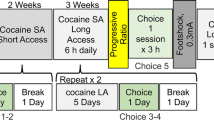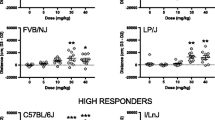Abstract
Rationale
Individual differences in the propensity to acquire drug self-administration may have a substantial genetic basis.
Objectives
To study the genetic contribution to cocaine self-administration by comparing hybrids of cocaine preferring (C57BL/6J) and nonpreferring (ICR) mice.
Methods
ICR and C57BL/6J parental strains were compared to hybrids with 75% ICR:25% C57BL/6J, 50% ICR:50% C57BL/6J, and 25% ICR:75% C57BL/6J genetic backgrounds for acquisition of sucrose pellet and intravenous cocaine self-administration in 1-h test sessions. Mice that acquired cocaine self-administration were subsequently tested in a between-session self-administration dose-response procedure.
Results
Increasing presence of C57BL/6J genes increased the percentage of mice that acquired sucrose pellet self-administration in the first test session. In lever-trained mice, only 19% of ICR mice met acquisition criteria for cocaine self-administration after 15 sessions, whereas 76% of C57BL/6J mice met acquisition criteria, although both strains initially sampled a similar number of cocaine injections. Increasing the percentage of C57BL/6J genes in the nonpreferring ICR background to 50 and 75% led to increasing percentages of mice that met acquisition criteria to 31 and 52%, respectively. In mice that acquired self-administration, only mice with 75% C57BL/6J genes showed a typical inverted U-shaped self-administration dose–response curve, whereas the curve was flat across doses for mice with ≤50 and 100% C57BL/6J genes.
Conclusions
The findings are consistent with a genetically based dose-dependent enhancement of cocaine reinforcement by C57BL/6J genes. These results suggest that heritable traits impart a substantial genetic load that facilitates the propensity for cocaine addiction among individuals in outbred populations.




Similar content being viewed by others
References
Bosy TZ, Ruth JA (1989) Differential inhibition of synaptosomal accumulation of [3H]-monoamines by cocaine, tropacocaine and amphetamine in four inbred strains of mice. Pharmacol Biochem Behav 34:165–172
Caine SB, Negus SS, Mello NK (1999) Method for training operant responding and evaluating cocaine self-administration behavior in mutant mice. Psychopharmacology 147:22–24
Carney JM, Landrum RW, Cheng MS, Seale TW (1991) Establishment of chronic intravenous drug self-administration in the C57BL/6J mouse. Neuroreport 2:477–480
Colby CR, Whisler K, Steffen C, Nestler EJ, Self DW (2003) Striatal cell type-specific overexpression of ?FosB enhances incentive for cocaine. J Neurosci 23:2488–2493
Crawley JN, Belknap JK, Collins A, Crabbe JC, Frankel W, Henderson N, Hitzemann RJ, Maxson SC, Miner LL, Silva AJ, Wehner JM, Wynshaw-Boris A, Paylor R (1997) Behavioral phenotypes of inbred mouse strains: implications and recommendations for molecular studies. Psychopharmacology 132:107–124
Deroche V, Caine SB, Heyser CJ, Polis I, Koob GF, Gold LH (1997) Differences in the liability to self-administer intravenous cocaine between C57BL/6 × SJL and BALB/cByJ mice. Pharmacol Biochem Behav 57:429–440
Grahame NJ, Cunningham CL (1995) Genetic differences in intravenous cocaine self-administration between C57BL/6J and DBA/2J mice. Psychopharmacology 122:281–291
Grahame NJ, Phillips TJ, Burkhart-Kasch S, Cunningham CL (1995) Intravenous cocaine self-administration in the C57BL/6J mouse. Pharmacol Biochem Behav 51:827–834
Hadfield MG (1995) Cocaine. Selective regional effects on central monoamines. Mol Neurobiol 11:47–53
He M, Shippenberg TS (2000) Strain differences in basal and cocaine-evoked dopamine dynamics in mouse striatum. J Pharmacol Exp Ther 293:121–127
Kuzmin A, Johansson B (2000) Reinforcing and neurochemical effects of cocaine: differences among C57, DBA, and 129 mice. Pharmacol Biochem Behav 65:399–406
Morse AC, Erwin VG, Jones BC (1993) Strain and housing affect cocaine self-selection and open-field locomotor activity in mice. Pharmacol Biochem Behav 45:905–912
Miner LL (1997) Cocaine reward and locomotor activity in C57BL/6J and 129/SvJ inbred mice and their F1 cross. Pharmacol Biochem Behav 58:25–30
Palmer AA, Low MJ, Grandy DK, Phillips TJ (2003) Effects of a Drd2 deletion mutation on ethanol-induced locomotor stimulation and sensitization suggest a role for epistasis. Behav Genet 33:311–324
Reeb-Whitaker CK, Paigen B, Beamer WG, Bronson RT, Churchill GA, Schweitzer IB, Myers DD (2001) The impact of reduced frequency of cage changes on the health of mice housed in ventilated cages. Lab Anim 35:58–73
Rocha BA, Odom LA, Barron BA, Ator R, Wild SA, Forster MJ (1998) Differential responsiveness to cocaine in C57BL/6J and DBA/2J mice. Psychopharmacology 138:82–88
Rocha BA, Goulding EH, O’Dell LE, Mead AN, Coufal NG, Parsons LH, Tecott LH (2002) Enhanced locomotor, reinforcing, and neurochemical effects of cocaine in serotonin 5-hydroxytryptamine 2C receptor mutant mice. J Neurosci 22:10039–10045
Ruth JA, Ullman EA, Collins AC (1988) An analysis of cocaine effects on locomotor activities and heart rate in four inbred mouse strains. Pharmacol Biochem Behav 29:157–162
Seale TW, Carney JM (1991) Genetic determinants of susceptibility to the rewarding and other behavioral actions of cocaine. J Addict Dis 10:141–162
Sedivy J, Joyner A (1992) Gene targeting. Freeman, New York
Szumlinski KK, Lominac KD, Frys KA, Midddaugh LD (2004) Genetic variations in heroin-induced changes in behaviour: effects of B6 strain dose on conditioned reward and locomotor sensitization in 129-B6 hybrid mice. Genes Brain Behav 4:324–326
Spanagel R, Sanchis-Segura C (2003) The use of transgenic mice to study addictive behaviour. Clin Neurosci Res 3:325–331
Thomsen M, Caine SB (2006) Cocaine self-administration under fixed and progressive ratio schedules of reinforcement: comparison of C57BL/6J, 129X1/SvJ, and 129S6/SvEvTac inbred mice. Psychopharmacology 184:145–154
Tolliver BK, Carney JM (1994) Sensitization to stereotypy in DBA/2J but not C57BL/6J mice with repeated cocaine. Pharmacol Biochem Behav 48:169–173
Tolliver BK, Belknap JK, Woods WE, Carney JM (1994) Genetic analysis of sensitization and tolerance to cocaine. J Pharmacol Exp Ther 270:1230–1238
Womer DE, Jones BC, Erwin VG (1994) Characterization of dopamine transporter and locomotor effects of cocaine, GBR 12909, epidepride, and SCH 23390 in C57BL and DBA mice. Pharmacol Biochem Behav 48:327–335
Zhang Y, Schlussman SD, Ho A, Kreek MJ (2001) Effect of acute binge cocaine on levels of extracellular dopamine in the caudate putamen and nucleus accumbens in male C57BL/6J and 129/J mice. Brain Res 923:172–177
Acknowledgements
This work was supported by United States Public Health Service Grants DA 10460, DA 08227, a fellowship from the Basque Government (E. R-D.), and the Wesley Gilliland Professorship in Biomedical Research.
Author information
Authors and Affiliations
Corresponding author
Rights and permissions
About this article
Cite this article
Ruiz-Durántez, E., Hall, S.K., Steffen, C. et al. Enhanced acquisition of cocaine self-administration by increasing percentages of C57BL/6J genes in mice with a nonpreferring outbred background. Psychopharmacology 186, 553–560 (2006). https://doi.org/10.1007/s00213-006-0379-2
Received:
Accepted:
Published:
Issue Date:
DOI: https://doi.org/10.1007/s00213-006-0379-2




